Workshops Offered & Brief
Resume
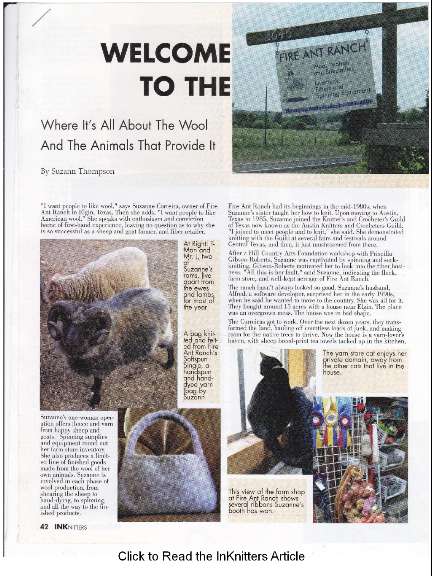
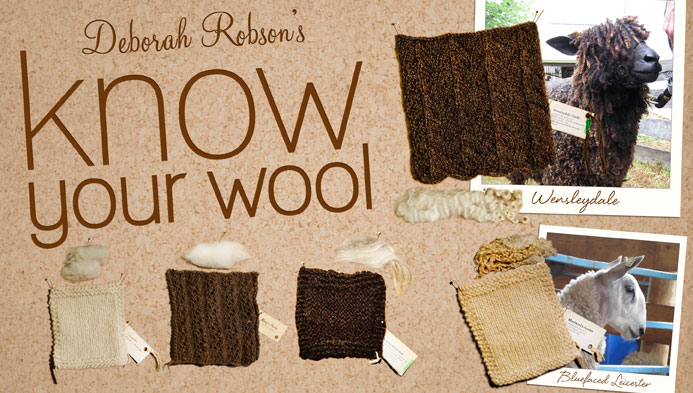
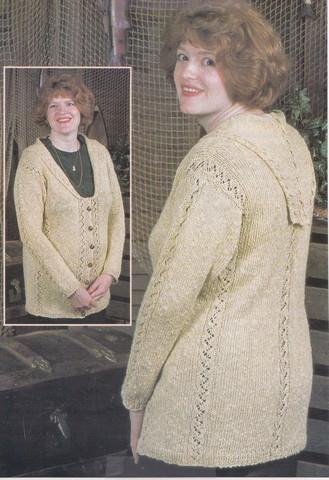
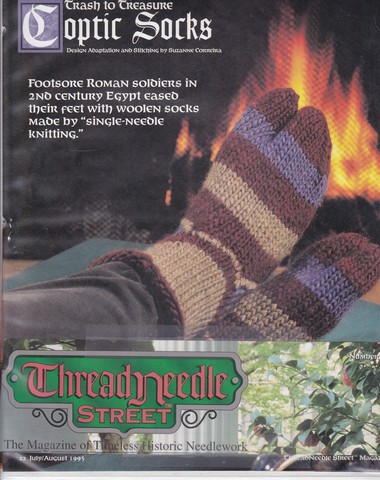
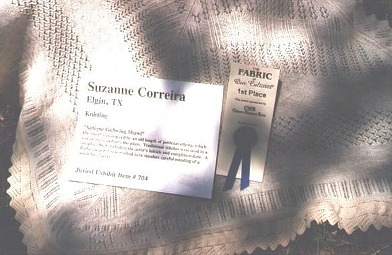
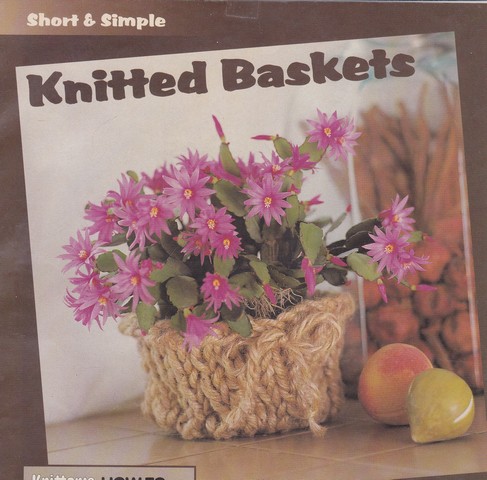
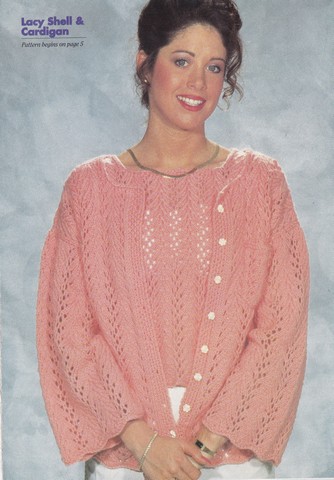

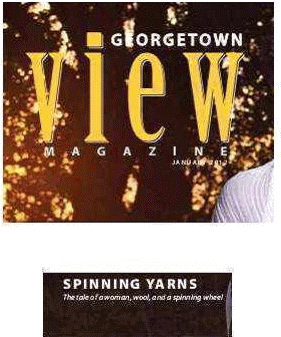
Suzanne has been knitting, dyeing,
spinning, weaving, designing and teaching professionally
since the late 1980s and has been a teacher/vendor/organizer
at many major festivals including Estes Park, Taos, Stitches
MW and others.
She is able to teach and organize
workshops for just about any fiber art she can do herself,
so if you don't see what you want, just ask! More will
be added as she discovers new passions and creates new
workshops.
A
list of current Workshops is below, and you may jump to the
categories from here:
Knitting
Spinning Weaving/Braiding
Everything
Else
These
can be offered off-site at festivals or guild meetings.
If you would prefer a printed copy of the Workshop Brochure,
it may be downloaded here.
Workshop Guidelines
A minimum number of participants set at 3 and a maximum number be
set at 12 or 15 (12 preferred) - is suggested.
Fewer students means more individual attention to the students.
There
is generally a set workshop fee for teaching (middle of the
road/reasonable). Assistance in either lodging or travel
is appreciated - this can be flexible. Workshop
organizers may set whatever student registration fee they
chose. Generally the materials charge is separate and
collected by Suzanne at the workshop and is kept reasonable
but fair for the materials. There is always an excellent
handout!
KNITTING
A New Take on the Bohus Style
Skill
Level: Advanced Beginner - must know how to cast on/bind
off, and knit in the round (for the full version). I FAVOR
using two circular needles, but you may use Magic Loop if you
must or certainly 4 or 5 double points.
Class
Length: This class works best as a Full Day (6 hour)
workshop although it can be structured as an INTRO 3 hour class
- students will learn and work a chart of Bohus knitting (back
and forth) to study the effects of the technique, but will NOT
be starting/working on a actual project. In the FULL
class, students will also start/work on (in the round) an actual
project of a pair of wristlets designed for the class.
Would you like to learn another style of colorwork?
Uncomfortable with handling many colors in a row? Come
join us in this adapted style of Bohus Knitting - we are
"cheating", but we will learn how to do it the traditional way
if you don't want to cheat. Bohus was developed in the
1930s as a mean of economic develop et. It is
traditionally done with an Angora-blend color yarn (many
different colors) on a plain wool yarn background. Purl
stitches add the unique texture that also creates the lovely
color blending. We will be working with fingering weight
yarn and not with Angora rabbit (for
those who are allergic). We will be working on wristlets.
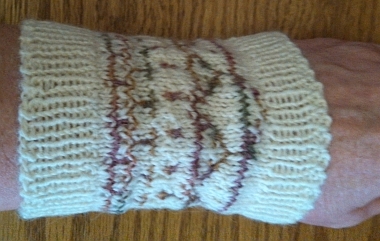
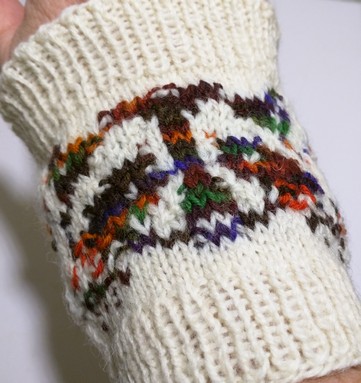
Spiffy
Socks Sassy Socks and Stockings, Suzanne Style
Skill Level: Advanced Beginner must know how to cast on,
cast off, increase & decrease
Class
Length: This class works best as a Full
Day (minimum 6 hours) workshop.
Socks are something that everybody needs but nobody seems to
really respect. And such a fun project to knit fast and
portable too. Get as fancy as you like, or as subtle.
Hand knit socks are just wonderful and fit SO well. Learn to
make your first pair of socks and youll never be able to
stop. OR if you already make socks, learn how to make knee
socks that fit as in Kilt Hose that stay up for that Scottish
gentleman of yours. Fit your sock to YOUR foot. Well
cover basic shaping, a heel or two, and tips on what stitch
patterns work best if you want to do a pair of kilt hose or other
fancy socks.
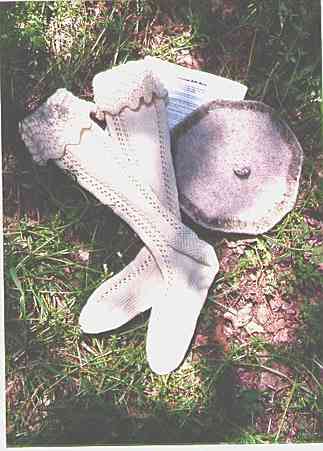
Kilt
Hose/Shaped Hose - we will learn how to shape, but not make a full
pair
Toe
Up on Two for your Tootsies
Skill Level: Advanced Beginner must know how to cast on,
cast off, increase & decrease
Class
Length: Works best as a Full Day Workshop as we cover a lot
of material and finish a sample sock or two.
Tired of boring basic socks? Ready to be adventurous and try
the Flip Side? Learn to start your sock from the Toe and
work UP! Socks do work both ways and while Top Down has been
the most popular way of making them for a long time, there have
always been those who have started at the other end. This is
a GREAT way to work a pair of socks when you're not sure how much
sock you can get out of your yarn or if you're not sure of the
sizing - try them on as you go! And using the two circular
needles just makes keeping track of everything much easier.
Two different beginnings, two heels and a wonderful bind off, plus
other techniques.
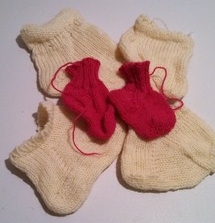
Shoulders
that Sing
Skill Level: Advanced Beginner - must know how to cast on,
cast off, increase & decrease
Class
Length: Half Day (3 hour) class WITH HOMEWORK BEFORE but
better as Full Day Class
There are shoulders and then there are SHOULDERS. They work
well in the round, they work well flat and they all keep the
sweater from falling off your body! All sorts of styles, all
sorts of ways of working them. Some of them are easy
to do and some are harder, but can be MADE easier. They can
be plain or decorative. Sewing can be involved or NOT.
Some styles work for some people and look awful on other
people.
Come
learn a bit about the different shoulder styles and several ways
of working and finishing them. We will practice on a few
types and learn how to put it all together!
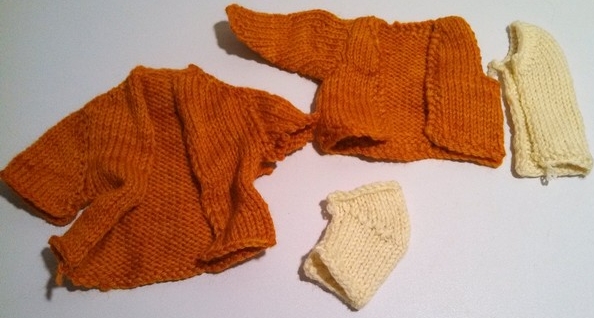
Patchwork
or Domino Knitting
Skill Level:
Advanced Beginner - must know how to cast on, cast off,
increase & decrease
Class
Length: Works best as a Full Day (6 hour) class
Patchwork Knitting is a very neat way to design sweaters and
accessories. You get very striking, designer effects with
very little effort. You'll
learn and/or refresh your skills in increasing and decreasing,
picking up along edges, and joining pieces as you work. You
will be able to practice weaving in ends. You'll learn new
ways to look at color and texture and how to design garments and
accessories using this fun technique that looks so much harder
than it really is! At the end of the class, students will
have made a small accessory bag for their knitting goodies.
This
is a great technique for using up all those odds and ends or
special yarns we make or buy on impulse.
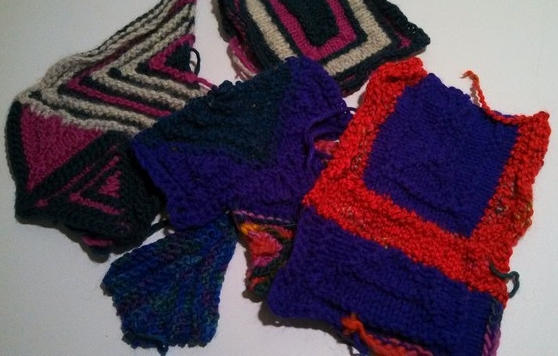
SPINNING
Making
Lumpy-Bumpy and Glamor Yarns
Skill Level:
Must be able to spin on a wheel but any skill level after
that
Class Length: Full Day or Half Day
There are two basic ways of making lumpy-bumpy yarn deliberately:
Creating Texture in the Singles and Texture in the Plying.
We'll learn how to do both, including making slubbed and
garneted yarns, knot yarns, tufted yarns, snarl yarns, etc.
We'll take you through some quick tricks with mohair and
other curly fibers, to get quick Designer Yarn results and some
easy plying tricks too. We'll also cover ways to spice up
your otherwise smooth yarns by experimenting with adding
other fibers.
Spinning with Beads and Knitting with Beaded Yarns
Skill Level: Advanced Beginner - should be able to spin on a
WHEEL and basics of knitting (cast on, cast off, knit/purl, etc)
Class Length: Full Day Class for BOTH sections (Spinning in
the AM and Knitting in the PM) - the basics of it work as a half
day class
Love those beaded yarns but some are just TOO glitzy? Or
maybe not glitzy enough? Want to make your own? Come
learn how to spin with beads. We are NOT talking about just
stringing the beads along the yarn as you play, but spinning them
ONTO the singles, as well as the other methods to add them to your
yarns. We will also learn about which beads work best, what
projects you can do and how to handle the beaded yarns in your
knitting for the best effect for your individual projects and
tastes.
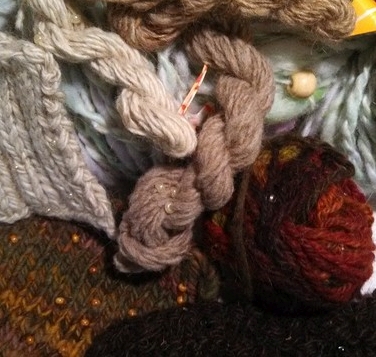
WEAVING & BRAIDING
Dorset Buttons
- a Woven Button Style
Skill Level: Beginner - able to handle a needle and
yarn. Working with small, but not necessarily teensy
things. A magnifier might be helpful, but not necessary.
Class
Length: Works best as a Full Day (6 hour) workshop.
The basic techniques are easy to learn for the morning session,
and the afternoon session can be devoted to learning different
techniques and making more buttons. Death's Head buttons may
also be covered if there is time.
Do you think a garment isn't finished until it has buttons?
Do you have your mother's or grandmother's button tin? Are
buttons your favorite souvenir because they're pretty, don't take
up much space and can be used for more than just fastening
things? Do you just love buttons? Then come play with
us and learn a button technique that combines your love of buttons
with weaving and yarn!
This
style of button started in the late 1600s as a cottage industry in
the Dorset district of the UK, and had its heyday up until
WW1. The originals are highly collectible and the modern
interpretations are gorgeous. Come enjoy this easy,
portable, FUN buttons technique!
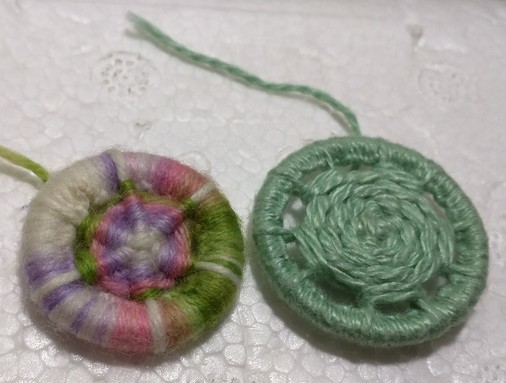
A
Good Beginning: Card Weaving
Skill Level: Beginner (or as a refresher) - No experience
necessary
Class
Length: Full Day Class recommended although it can be a Half
Day
You can weave with cards? With holes in them? Yes
indeed! Cards, Tablets, Beer Coasters, anything that is
somewhat stiff, comfortable to hold in the hand,
and generally square, although other shapes can be
used. This is a simple, easy-resource method that can
produce very complex weaves, or not, as you choose.
Work to a pattern, or create your own. And oh so
portable! You are only tied down to the weaving when you are
actually weaving, or not at all with a frame.
Think of this as a Beginner or Refresher class in the ancient
tradition of Tablet Weaving a multicultural, warp-faced weave
generally used for narrow goods.
Go to Top of Page
EVERYTHING ELSE!
Rope
Making, Cord Making, Lead Ropes & Leashes - REALLY
FAT YARN!
Skill Level: No experience necessary
Class Length: Works great as a half day class
Come discover or re-discover the fun of making rope al la Girl
Scouts/Boy Scouts, with a bit of refinement. We will learn
how to make ouri own cordage using a strong WOOL, (yes, wool)
yarn, and everybody will go home with SOME sort of rope, generally
a leash for the family dog. We will learn about the
beginnings (the raw materials), the middles (the twisting) and the
ends (finishing touches). There will be lots of laughing and
teamwork is a key!
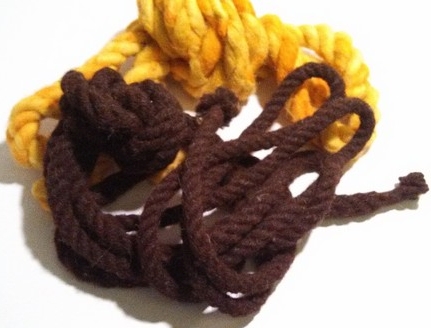
Knitted/Crocheted/Woven
or Cut & Sew Cocoon
Skill
Level: Any level of fiber worker in any discipline -
simple hand sewing skills needed
Class
Length: Good Half Day (3 hr) Class
Make a glamorous yet so easy garment that is flattering to just
about every female shape. Gauge it for your own yarn,
needles & style of knitting, crocheting or weaving. Or
go through that stash of fabulous drapeable fabric you couldn't
resist buying! This is another great idea for those odds
& ends that you wouldn't necessarily want to use in a
Patchwork Knitting garment or accessorie. Take some of
those older rectangular shawls and wide scarves you played
around with and turn them into a dramatic garment.
How to Play
Dirty - aka - Mud Dyeing!
Skill Level:
Any - no experience necessary
Class
Length: Can be either Full Day (6 hr) or Half Day (3 hr)
Class
Come join us as
we play in the mud and get great natural colors to boot.
Mud and clay can be used for soak dyeing and painting on many
fabrics and fibers. We will explore these techniques
using different muds and clays, plus different
fixatives. Some results can be seen immediately (think
of the kids' clothing when they come in from playing in the
mud), while others may take weeks, or even months to see the
final (spectacular) results which are Semi-permanent to
Permanent and really another version of natural dyeing.
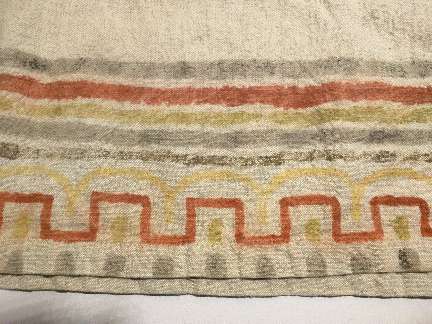
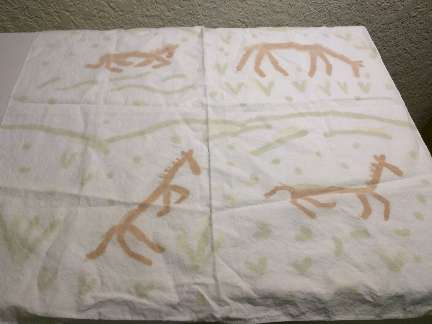
Inlaid Felting
- a Hot Pad Project
Skill Level: Any - no experience necessary
Class
Length: Good Half Day (3 hr) Class or can be a Full Day
Class (6 hr) with more finished felting
This is exactly what it sounds like: Putting one piece of
felt into another. Learned from Alexander Pilin, a noted
Russian felter, this method is light on the use of water or
soap, until the final hardening stage. We will use felting
needles and threads and yarns not so much as design elements,
but for beginning construction of the pieces. In a Pilin
workshop, you would most likely be making a rug - here we will
make a hot pad or two.
In
the Works or being Revamped
Kumihimo
(Japanese Braiding) -
reworking it with new braid ideas & tools
Make
your own Fiber Tools -
an old favorite that is getting a makeover
Using
Weaving (Sewing) Patterns for Knitting - more
ideas like the Cocoon
Go to Top of Page

















